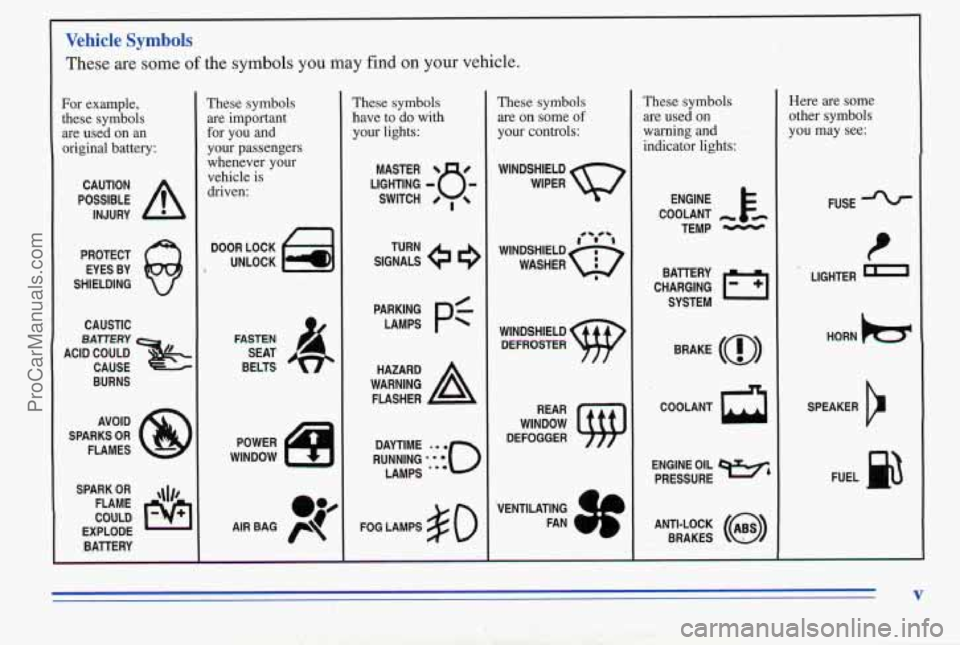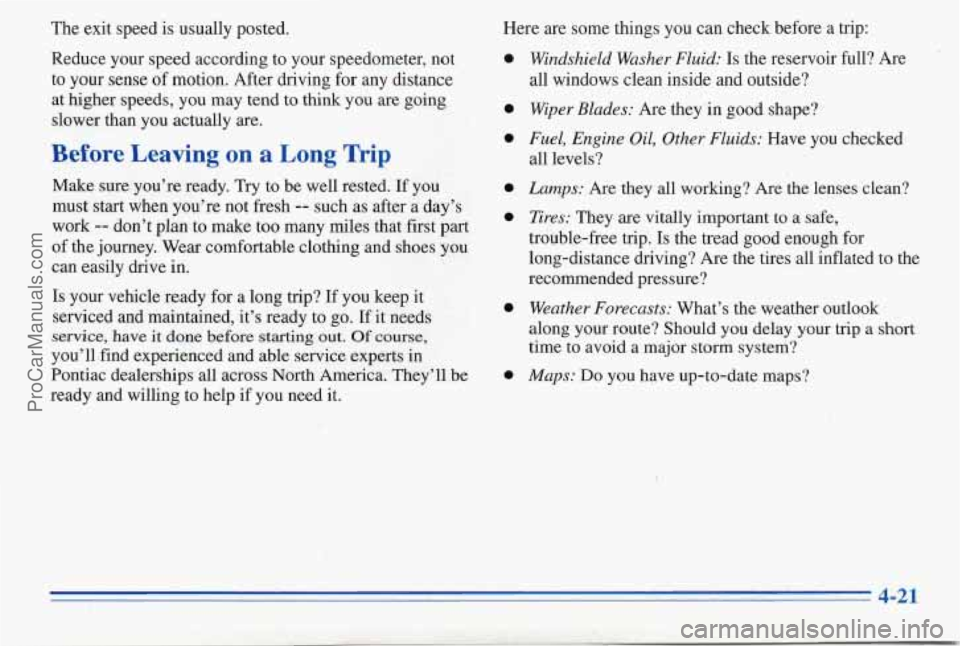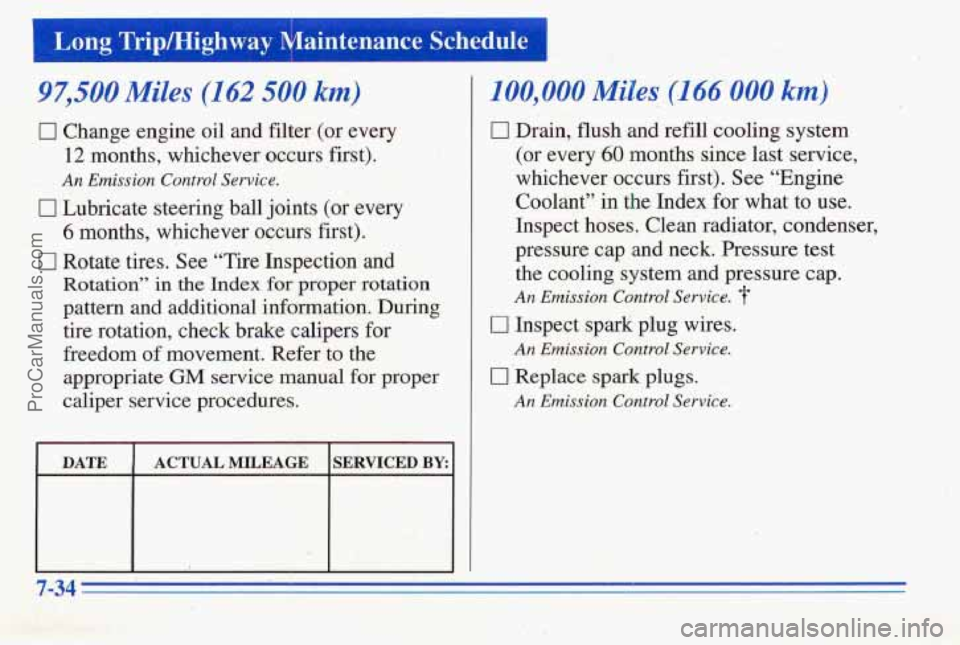1996 PONTIAC PONTIAC oil pressure
[x] Cancel search: oil pressurePage 6 of 370

1
Vehicle Symbols
These are some of the symbols you may find on your vehicle.
For example,
these symbols are used on an
original battery:
POSSIBLE A
CAUTION
INJURY
PROTECT EYES BY
SHIELDING
CAUSTIC
ACIEEZ CAUSE
BURNS
AVOID
SPARKS
OR
FLAMES
SPARK
OR ,\I/,
COULD FLAME
EXPLODE BATTERY
These symbols
are important
for you and
your passengers
whenever your
vehicle is driven:
DOOR LOCK
UNLOCK
FASTEN SEAT
BELTS
POWER
WINDOW
c
These symbols
have to do with
your lights:
SIGNALS e 9
TURN
PARKING
PC
LAMPS
FOG LAMPS $0
These symbols
are
on some of
your controls:
WINDSHIELD
WIPER
'VENTILATING
FAN
These symbols
are used on
warning and
indicator lights:
COOLANT -
TEMP -
CHARGING 1-1
BATTERY
SYSTEM
BRAKE
(0)
COOLANT a
ENGINE OIL w,
PRESSURE
ANTI-LOCK
(@)
BRAKES
Here are some
other symbols
you may see:
FUSE
P
LIGHTER m
HORN )cr
SPEAKER
b
FUEL e3
V
ProCarManuals.com
Page 124 of 370

0 If you make a hard stop, the light may come on for a
moment. This is normal.
A CAUTION:
-
Don’t keep driving if the oil pressure is low. If
you do, your engine can become so hot that it
catches fire. You or others could be burned.
Check your
oil as soon as possible and have your
vehicle serviced.
I NOTICE: I
Damage to your engine from neglected oil
problems can be costly and
is not covered by
your warranty.
Low Oil Level Light
LOW OIL
LEVEL
Your engine is equipped
with an oil level monitoring
system. When the ignition
key is turned on, the LOW
‘OIL LEVEL light will
briefly flash. If the light
does not, flash, have it fixed
so it will be ready to warn
you if there’s a problem.
If the light stays on, stop the vehicle on a level surface
and turn the engine
off. Check the oil level using the
engine oil dipstick. (See “Engine Oil” in the Index.)
If the light does not flash, have the low oil level sensor
system repaired
so it will be ready to warn you if there’s
a problem.
,
The oil level monitoring system only checks oil level
during the brief period between key on and engine
crank. It does not monitor engine oil level when the “ .
engine is running. Additionally, an oil level check is
only performed if the engine has been turned off for a
considerable period of time, allowing the oil normally in
circulation to drain back into the
oil pan.
ProCarManuals.com
Page 176 of 370

The exit speed is usually posted.
Reduce your speed according to your speedometer, not
to your sense of motion. After driving for any distance
at higher speeds, you may tend to think you are going
slower than you actually
are.
Before Leaving on a Long Trip
Make sure you're ready. Try to be well rested. If you
must
start when you're not fresh -- such as after a day's
work
-- .don't plan to make too many miles that first part
of the journey. Wear comfortable clothing and shoes you
can easily drive in.
Is your vehicle ready for a long trip? If you keep it
serviced and maintained, it's ready to go. If it needs
service, have it done before starting out. Of course,
you'll.find experienced and able service experts in
Pontiac dealerships all across
North America. They'll be
ready and willing to help if you need it. Here are some things
you can check before a trip:
0
0
0
a
a
0
a
Windshield Washer Fluid: Is the reservoir full? Are
all windows clean inside and outside?
Wiper Blades:
Are they'in good shape?
Fuel, Engine Oil, Other Fluids: Have you checked
all levels?
Lamps: Are they all working? Are the lenses clean?
Tires: They are vitally important to a safe,
trouble-free trip.
Is the tread good enough for
long-distance driving?
Are the tires all inflated to the
recommended pressure?
Weather Forecasts: What's the weather outlook
along your route? Should you delay your trip a
short
time to avoid a major storm system?
Maps:
Do you have up-to-date maps?
4-21
ProCarManuals.com
Page 285 of 370

Using Solvent-Qpe Cleaner on Fabric
First, see if you have to use solvent-type cleaner at all.
Some.spots
and stains will clean off better with just
water
and miId soap.
If you need to use a solvent:
Gently scrape excess soil from.the trim material with
a clean, dull knife or scraper. Use very little 'cleaner,
light pressure and clean cloths (preferably
cheesecloth). Cleaning should start at the outside of
the stain, "feathering" toward the center. Keep
changing,to
a ,. clean section of the cloth.
When you clean a stain from fabric, immediately
dry the area with a blow dryer to help prevent a
cleaning ring.
SpeciaI Cleaning Problem
Greasy ar Oily Stab
Stains caused by grease, oil, butter, margarine, shoe
polish, coffee with cream, chewing gum,-cosmetic
I
creams, vegetable oils, wax crayon, tar and asphalt can
be removed
as follows:
1. Carefully scrape off excess stain.'
2., Follow the solvent-type instructions described earlier.
3. Shoe polish, wax crayon, tar and asphalt will stain if
left on a vehicle's seat fabric. They should be removed
as soon as possible. Be careful, because the cleaner
will dissolve them and may cause ,them to spread.
Non-Greasy Stains
Stains caused by catsup, coffee (black), egg, fruit, fruit
juice,
milk, soft drinks, wine, vomit, urine and blood can
be removed as follows:
1. Carefully scrape off excess stain, then sponge the
2. If a stain remains, follow the foam-type instructions
described earlier.
3. If an odor lingers after cleaning vomit or urine,
treat
the area with a waterhaking soda solution:
1 teaspoon (5 ml) of baking soda to 1 cup (250 ml)
soiled
area with cool water. of lukewarm wate~:~,.'-~~"':~-r-'~!,: - .C \ . ...' E% 7:- 3-b: .-,3-. , . .' *'
4. Lf needed, clean lightly with solvent-type cleaner.
Combination. Stains
Stains caused by candy,'ice,cream, mayonnaise, chili
sauce and unknown stains can be removed as follows:
Carefully scrape off excess stain, then clean with
0 If a stain remains, clean it with solvent-type cleaner.
cool water and allow to dry.
6-58
ProCarManuals.com
Page 337 of 370

1 Lung Trip/Highway Maintenance Schedule I
I 97,500 Miles (162 500 km)
0 Change engine oil and filter (or every
12 months, whichever, occurs first).
0 Lubricate steering ball joints (or every
6 months, whichever occurs first).
0 Rotate tires. See “Tire Inspection and
Rotation” in the Index for proper rotation
pattern and additional information. During
tire rotation, check brake calipers for
freedom of movement,. Refer to the
appropriate
GM service manual for proper
caliper service procedures.
An Emission Control Sewice.
DATE ACTUALMILEAGE SERVICED BY: ’
100,000 Miles (1 66 000 km)
0 Drain, flush and refill cooling system
(or ‘every 60 months since last service,
whichever occurs first). See “Engine
Coolant”
in the Index for what to use.
Inspect hoses, Clean radiator, condenser,
pressure cap and neck.
Pressure test
the cooling system and pressure cap.
An Emission Control Service.
0 Inspect spark plug wires.
0 -Replace spark plugs. .
An Emission Control Service.
An Emission Control Service.
7-34
ProCarManuals.com
Page 339 of 370

Part B: Owner Checks and Services Windshield Washer Fluid Level Check
Listed below are owner checks and services whch Check the windshield washer fluid level in the
should be performed at the intervals specifi’ed to help windshield washer tank and add the proper
fluid if
ensure the safety, dependability and emission control necessary. See “Windshield Washer Fluid” in the Index
performance
of your vehicle. for further details.
Be sure
any necessary repairs are completed at once. At Least Once a Month
Whenever any fluids or lubricants are added to your .- e:. .r- ....
vehicle, make sure they are the proper ones, as shown )z., I ” lire Inflation Check
in Part D. Make sure tires are inflated to the correct pressures.
At Each Fuel Fill See “Tires” in the Index for further details.
It is important for you or a service station attendant to Cassette Deck Service
perjom these underhoad checks at each fuel fill. Clean cassette deck. Cleaning should be done every
Engine Oil Level Check
Check the engine oil level and add the proper oil
if necessary. See “Engine Oil” in the Index for
further details.
50 hours of tape play. See “Audio Systems” in the
Index for further details.
Engine Coolant Level Check
Check the engine coolant level and add the proper
coolant mix if necessary. & ,.. ‘TQgine _i. Coolant” in the
Index for further details. I,
Power Antenna Service
Clean power antenna mast. See “Audio Systems” in the
Index for further details.
ProCarManuals.com